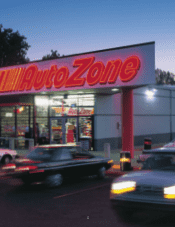AutoZone 1999 Annual Report Download - page 21
Download and view the complete annual report
Please find page 21 of the 1999 AutoZone annual report below. You can navigate through the pages in the report by either clicking on the pages listed below, or by using the keyword search tool below to find specific information within the annual report.19
The total estimated cost of the Year 2000 project is $10 to
$11 million, which is being expensed as incurred. As of August
28, 1999, approximately $8 million of this budget had been
incurred. All of the related costs are being funded through
operating cash flows. These costs are an immaterial part of the
overall information technology budget. No major information
technology projects or programs have been deferred.
In addition to internal systems, the Company is addressing
Year 2000 issues which do not normally fall under information
technology such as embedded chip equipment and the
compliance status of business partners. The Company has
addressed over 95% of the critical issues in this category. The
Company is also assessing the Year 2000 readiness of its
merchandise vendors, most of which communicate with the
Company through electronic data interchange (EDI). The
Company plans to complete Year 2000 testing of the EDI system
with all critical vendors during October 1999.
Although the Company believes that the ongoing
assessment and testing will minimize its overall Year 2000 risks,
there is no guarantee that there will not be an adverse effect on
the Company if third parties such as merchandise vendors,
service providers or utility companies are not Year 2000 ready.
The Company has developed detailed contingency plans for
critical systems, processes and business partners. Elements of
the CompanyÕs contingency plans include: switching vendors,
increasing the inventory levels of certain products, back-up
systems and manual processes.
While the Company does not anticipate any major business
disruptions as a result of Year 2000 issues, it is possible that
certain disruptions may occur including loss of communications
with stores, distribution centers or business partners; inability to
process transactions in a timely manner or loss of power. The
Company plans to have dedicated resources available to address
any Year 2000 issue that may arise. These resources will be
managed through a dedicated command center and consist of
technical personnel, business leaders and members of senior
management.
Inflation
The Company does not believe its operations have been
materially affected by inflation. The Company has been
successful, in many cases, in mitigating the effects of
merchandise cost increases principally due to economies of
scale resulting from increased volumes of purchases, selective
forward buying and the use of alternative suppliers.
Seasonality and Quarterly Periods
The CompanyÕs business is somewhat seasonal in nature,
with the highest sales occurring in the summer months of June
through August, in which average weekly per store sales
historically have been about 20% to 30% higher than in the
slowest months of December through February. The CompanyÕs
business is also affected by weather conditions. Extremely hot or
extremely cold weather tends to enhance sales by causing parts to
fail and spurring sales of seasonal products. Mild or rainy weather
tends to soften sales as partsÕ failure rates are lower in mild
weather and elective maintenance is deferred during periods of
rainy weather.
Each of the first three quarters of AutoZoneÕs fiscal year
consists of twelve weeks and the fourth quarter consists of sixteen
weeks. Because the fourth quarter contains the seasonally high
sales volume and consists of sixteen weeks, compared to twelve
weeks for each of the first three quarters, the CompanyÕs fourth
quarter represents a disproportionate share of the annual net sales
and net income. The fourth quarter of fiscal 1
9
99 represented
33.8% of annual net sales and 40.3% of net income; the fourth
quarter of fiscal 1998 represented 37.5% of annual net sales and
40.4% of net income.
Forward-Looking Statements
Certain statements contained in the Financial Review and
elsewhere in this annual report are forward-looking statements.
These statements discuss, among other things, expected growth,
domestic and international development and expansion strategy,
business strategies and future performance. These forward-
looking statements are subject to risks, uncertainties and
assumptions, including without limitation, competition, product
demand, domestic and international economies, government
approvals, the ability to hire and retain qualified employees,
consumer debt levels, inflation and the weather. Actual results
may materially differ from anticipated results. For more
information, please see the Risk Factors section of the
CompanyÕs most recent Form 10-K as filed with the Securities
and Exchange Commission.
























